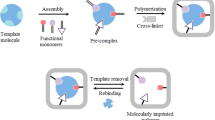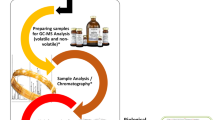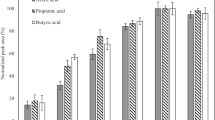Abstract
Highly efficient extraction of peptides from serum is critical for finding serum biomarkers using mass spectrometry, which still remains a great challenge. Currently, a bottom-up proteomics approach has been applied to discover serum biomarkers. However, the approach was labor intensive, time and cost consuming, and cannot meet the requirements for clinical application. In this work, Fe3O4/C@MIL-100 composites were synthesized to efficiently capture peptides from microwave-assisted formic acid digests of BSA and human serum prior to MALDI-TOF MS analysis. Fe3O4/C@MIL-100 composites exhibited size-selective adsorption performance, thus providing a rapid and convenient approach to enrich low-abundance peptides. Notably, the peptides’ mass fingerprinting of serum digestions between type 2 diabetes mellitus (T2DM) and healthy persons were distinguishable, which indicated the potential ability of this technique for T2DM diagnosis and rapid biomarker discovery.

Efficient extraction and identification of serum biomarkers using Fe3O4/C@MIL-100 composites from acid hydrolysate






Similar content being viewed by others
References
Aebersold R, Mann M. Mass spectrometry-based proteomics. Nature. 2003;422(6928):198–207.
Rodrigo MA, Zitka O, Krizkova S, Moulick A, Adam V, Kizek R. MALDI-TOF MS as evolving cancer diagnostic tool: a review. J Pharm Biomed Anal. 2014;95:245–55.
Ahmed N, Barker G, Oliva K, Garfin D, Talmadge K, Georgiou H, et al. An approach to remove albumin for the proteomic analysis of low abundance biomarkers in human serum. Proteomics. 2003;3(10):1980–7.
Berna M, Ackermann B. Increased throughput for low-abundance protein biomarker verification by liquid chromatography/tandem mass spectrometry. Anal Chem. 2009;81(10):3950–6.
Cho YT, Su H, Huang TL, Chen HC, Wu WJ, Wu PC, et al. Matrix-assisted laser desorption ionization/time-of-flight mass spectrometry for clinical diagnosis. Clin Chim Acta. 2013;415:266–75.
Switzar L, Giera M, Niessen WM. Protein digestion: an overview of the available techniques and recent developments. J Proteome Res. 2013;12(3):1067–77.
Lill JR, Ingle ES, Liu PS, Pham V, Sandoval WN. Microwave-assisted proteomics. Mass Spectrom Rev. 2007;26(5):657–71.
Li A, Sowder RC, Henderson LE, Moore SP, Garfinkel DJ, Fisher RJ. Chemical cleavage at aspartyl residues for protein identification. Anal Chem. 2001;73(22):5395–402.
Swatkoski S, Gutierrez P, Wynne C, Petrov A, Dinman JD, Edwards N, et al. Evaluation of microwave-accelerated residue-specific acid cleavage for proteomic applications. J Proteome Res. 2008;7(2):579–86.
Swatkoski S, Russell SC, Edwards N, Fenselau C. Rapid chemical digestion of small acid-soluble spore proteins for analysis of Bacillus spores. Anal Chem. 2006;78(1):181–8.
Alam A, Mataj A, Yang Y, Boysen RI, Bowden DK, Hearn MT. Rapid microwave-assisted chemical cleavage-mass spectrometric method for the identification of hemoglobin variants in blood. Anal Chem. 2010;82(21):8922–30.
Zhang N, Li N, Li L. Liquid chromatography MALDI MS/MS for membrane proteome analysis. J Proteome Res. 2004;3(4):719–27.
Zhong H, Marcus SL, Li L. Microwave-assisted acid hydrolysis of proteins combined with liquid chromatography MALDI MS/MS for protein identification. J Am Soc Mass Spectrom. 2005;16(4):471–81.
Swatkoski S, Gutierrez P, Ginter J, Petrov A, Dinman JD, Edwards N, et al. Integration of residue-specific acid cleavage into proteomic workflows. J Proteome Res. 2007;6(11):4525–7.
Lo LH, Huang TL, Shiea J. Acid hydrolysis followed by matrix-assisted laser desorption/ionization mass spectrometry for the rapid diagnosis of serum protein biomarkers in patients with major depression. Rapid Commun Mass Spectrom. 2009;23(5):589–98.
Huang T-L, Cho Y-T, Su H, Shiea J. Principle component analysis combined with matrix-assisted laser desorption ionization mass spectrometry for rapid diagnosing the sera of patients with major depression. Clin Chim Acta. 2013;424:175–81.
Gu Z-Y, Yang C-X, Chang N, Yan X-P. Metal–organic frameworks for analytical chemistry: from sample collection to chromatographic separation. Acc Chem Res. 2012;45(5):734–45.
Gu Z-Y, Chen Y-J, Jiang J-Q, Yan X-P. Metal–organic frameworks for efficient enrichment of peptides with simultaneous exclusion of proteins from complex biological samples. Chem Commun (Camb). 2011;47(16):4787–9.
Ji Y, Xiong Z, Huang G, Liu J, Zhang Z, Liu Z, et al. Efficient enrichment of glycopeptides using metal–organic frameworks by hydrophilic interaction chromatography. Analyst. 2014;139(19):4987–93.
Zhao M, Deng C, Zhang X. The design and synthesis of a hydrophilic core–shell–shell structured magnetic metal–organic framework as a novel immobilized metal ion affinity platform for phosphoproteome research. Chem Commun (Camb). 2014;50(47):6228–31.
Meng J, Shi C, Wei B, Yu W, Deng C, Zhang X. Preparation of Fe3O4@C@PANI magnetic microspheres for the extraction and analysis of phenolic compounds in water samples by gas chromatography–mass spectrometry. J Chromatogr A. 2011;1218(20):2841–7.
Hortin GL, Sviridov D, Anderson NL. High-abundance polypeptides of the human plasma proteome comprising the top 4 logs of polypeptide abundance. Clin Chem. 2008;54(10):1608–16.
Anderson NL. The human plasma proteome: history, character, and diagnostic prospects. Mol Cell Proteomics. 2002;1(11):845–67.
Bandow JE. Comparison of protein enrichment strategies for proteome analysis of plasma. Proteomics. 2010;10(7):1416–25.
Li P, Yang J, Ma Q-Y, Wu Z, Huang C, Li X-Q, et al. Biomarkers screening between preoperative and postoperative patients in pancreatic cancer. Asian Pac J Cancer Prev. 2013;14(7):4161–5.
Liao J, Zhang R, Qian H, Cao L, Zhang Y, Xu W, et al. Serum profiling based on fucosylated glycoproteins for differentiating between chronic hepatitis B and hepatocellular carcinoma. Biochem Biophys Res Commun. 2012;420(2):308–14.
Kikkawa S, Sogawa K, Satoh M, Umemura H, Kodera Y, Matsushita K, et al. Identification of a novel biomarker for biliary tract cancer using matrix-assisted laser desorption/ionization time-of-flight mass spectrometry. Int J Proteomics. 2012;2012:1–8.
Kaur P, Rizk NM, Ibrahim S, Younes N, Uppal A, Dennis K, et al. iTRAQ-based quantitative protein expression profiling and MRM verification of markers in type 2 diabetes. J Proteome Res. 2012;11(11):5527–39.
Sundsten T, Ostenson CG, Bergsten P. Serum protein patterns in newly diagnosed type 2 diabetes mellitus—influence of diabetic environment and family history of diabetes. Diabetes Metab Res Rev. 2008;24(2):148–54.
Lu CH, Lin ST, Chou HC, Lee YR, Chan HL. Proteomic analysis of retinopathy-related plasma biomarkers in diabetic patients. Arch Biochem Biophys. 2013;529(2):146–56.
Acknowledgements
This work was supported by the National Natural Science Foundation of China (grants 21475095, 21106101, 81473472) and the Tianjin Natural Science Foundation (12JCZDJC29500, 13JCQNJC06300). Also, we are thankful to Technology Support Center of Tianjin Institute of Industrial Biotechnology, Chinese Academy of Sciences for providing the use of experimental instruments and materials.
Author information
Authors and Affiliations
Corresponding authors
Ethics declarations
Conflict of interest
The authors declare that they have no competing interests.
Human rights and informed consent
All procedures performed in studies involving human participants (healthy volunteers and patients) have been approved by the ethics committee and have been performed in accordance with ethical standards. Informed consent was obtained from all individual participants included in the study. This article does not contain any studies with animals performed by any of the authors.
Electronic supplementary material
Below is the link to the electronic supplementary material.
ESM 1
(PDF 415 kb)
Rights and permissions
About this article
Cite this article
Wei, JP., Wang, H., Luo, T. et al. Enrichment of serum biomarkers by magnetic metal-organic framework composites. Anal Bioanal Chem 409, 1895–1904 (2017). https://doi.org/10.1007/s00216-016-0136-2
Received:
Revised:
Accepted:
Published:
Issue Date:
DOI: https://doi.org/10.1007/s00216-016-0136-2




